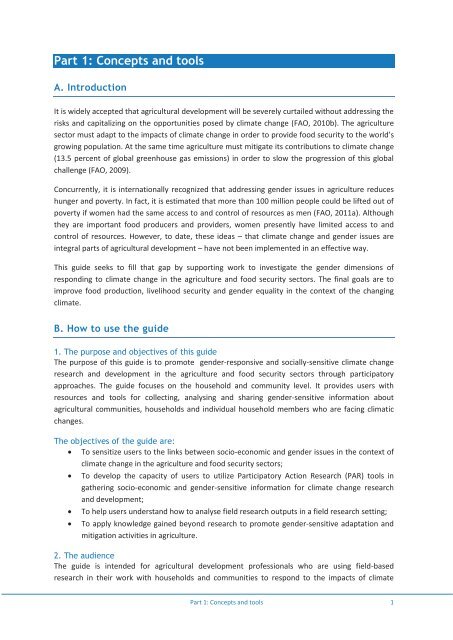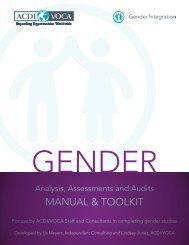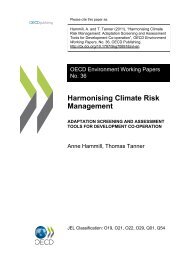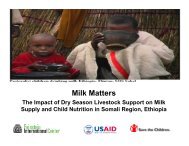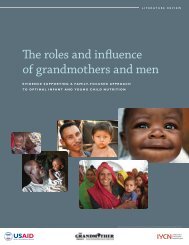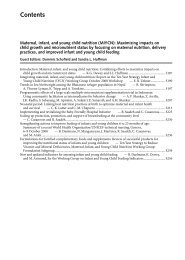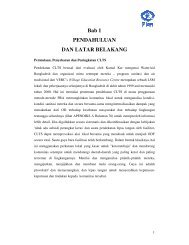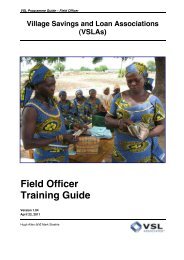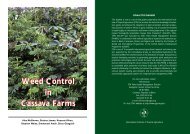Gender and climate change research in - FAO
Gender and climate change research in - FAO
Gender and climate change research in - FAO
Create successful ePaper yourself
Turn your PDF publications into a flip-book with our unique Google optimized e-Paper software.
Part 1: Concepts <strong>and</strong> tools<br />
A. Introduction<br />
It is widely accepted that agricultural development will be severely curtailed without address<strong>in</strong>g the<br />
risks <strong>and</strong> capitaliz<strong>in</strong>g on the opportunities posed by <strong>climate</strong> <strong>change</strong> (<strong>FAO</strong>, 2010b). The agriculture<br />
sector must adapt to the impacts of <strong>climate</strong> <strong>change</strong> <strong>in</strong> order to provide food security to the world’s<br />
grow<strong>in</strong>g population. At the same time agriculture must mitigate its contributions to <strong>climate</strong> <strong>change</strong><br />
(13.5 percent of global greenhouse gas emissions) <strong>in</strong> order to slow the progression of this global<br />
challenge (<strong>FAO</strong>, 2009).<br />
Concurrently, it is <strong>in</strong>ternationally recognized that address<strong>in</strong>g gender issues <strong>in</strong> agriculture reduces<br />
hunger <strong>and</strong> poverty. In fact, it is estimated that more than 100 million people could be lifted out of<br />
poverty if women had the same access to <strong>and</strong> control of resources as men (<strong>FAO</strong>, 2011a). Although<br />
they are important food producers <strong>and</strong> providers, women presently have limited access to <strong>and</strong><br />
control of resources. However, to date, these ideas – that <strong>climate</strong> <strong>change</strong> <strong>and</strong> gender issues are<br />
<strong>in</strong>tegral parts of agricultural development – have not been implemented <strong>in</strong> an effective way.<br />
This guide seeks to fill that gap by support<strong>in</strong>g work to <strong>in</strong>vestigate the gender dimensions of<br />
respond<strong>in</strong>g to <strong>climate</strong> <strong>change</strong> <strong>in</strong> the agriculture <strong>and</strong> food security sectors. The f<strong>in</strong>al goals are to<br />
improve food production, livelihood security <strong>and</strong> gender equality <strong>in</strong> the context of the chang<strong>in</strong>g<br />
<strong>climate</strong>.<br />
B. How to use the guide<br />
1. The purpose <strong>and</strong> objectives of this guide<br />
The purpose of this guide is to promote gender-responsive <strong>and</strong> socially-sensitive <strong>climate</strong> <strong>change</strong><br />
<strong>research</strong> <strong>and</strong> development <strong>in</strong> the agriculture <strong>and</strong> food security sectors through participatory<br />
approaches. The guide focuses on the household <strong>and</strong> community level. It provides users with<br />
resources <strong>and</strong> tools for collect<strong>in</strong>g, analys<strong>in</strong>g <strong>and</strong> shar<strong>in</strong>g gender-sensitive <strong>in</strong>formation about<br />
agricultural communities, households <strong>and</strong> <strong>in</strong>dividual household members who are fac<strong>in</strong>g climatic<br />
<strong>change</strong>s.<br />
The objectives of the guide are:<br />
To sensitize users to the l<strong>in</strong>ks between socio-economic <strong>and</strong> gender issues <strong>in</strong> the context of<br />
<strong>climate</strong> <strong>change</strong> <strong>in</strong> the agriculture <strong>and</strong> food security sectors;<br />
To develop the capacity of users to utilize Participatory Action Research (PAR) tools <strong>in</strong><br />
gather<strong>in</strong>g socio-economic <strong>and</strong> gender-sensitive <strong>in</strong>formation for <strong>climate</strong> <strong>change</strong> <strong>research</strong><br />
<strong>and</strong> development;<br />
To help users underst<strong>and</strong> how to analyse field <strong>research</strong> outputs <strong>in</strong> a field <strong>research</strong> sett<strong>in</strong>g;<br />
To apply knowledge ga<strong>in</strong>ed beyond <strong>research</strong> to promote gender-sensitive adaptation <strong>and</strong><br />
mitigation activities <strong>in</strong> agriculture.<br />
2. The audience<br />
The guide is <strong>in</strong>tended for agricultural development professionals who are us<strong>in</strong>g field-based<br />
<strong>research</strong> <strong>in</strong> their work with households <strong>and</strong> communities to respond to the impacts of <strong>climate</strong><br />
Part 1: Concepts <strong>and</strong> tools 1


